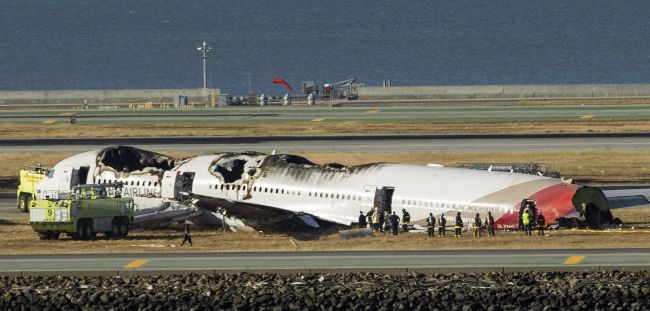Asiana Airlines’ passenger plane carrying 307 people crash-landed at San Francisco International Airport on Saturday (local time), killing at least two people, who were Chinese girls, and injuring about 180 others on board, officials in Seoul said.
The cause of the accident was not immediately known. The U.S. government said it is looking into what caused the accident. President Barack Obama received a report on the accident shortly after it happened, according to the White House. He ordered his staff to stay “in constant contact” with the federal, state and local partners in response to the crash, it added.
In Seoul, President Park Geun-hye expressed deep condolences to the victims and their families and vowed to spare no efforts to support the early containment of the fallouts from the accident.
 |
Firemen enter a Boeing 777 airplane that crashed while landing at San Francisco International Airport in California on Saturday. (AFP-Yonhap News) |
The Ministry of Land, Infrastructure and Transport sent a task force team to San Francisco on Sunday afternoon for the joint inspection of the cause of the crash landing.
In a press briefing, Asiana Airlines CEO Yoon Young-doo made an apology and promised to speed up his efforts to determine the cause of the crash and to take follow-up measures for passengers and their families.
According to the U.S. Federal Aviation Administration, the crash of Asiana flight 214 occurred at around 11:40 a.m. (San Francisco time). Witnesses said the Boeing 777 flight’s tail hit the ground and broke off, sending the jet spinning out of control.
Television footage showed considerable damage to the plane’s fuselage, wings and tail section. One engine may have detached from the plane following the crash. Also posted on YouTube were some videos showing a plume of smoke rising from the crashed plane.
“We were very lucky that we have so many survivors,” San Francisco Mayor Edwin Lee said at a briefing at the airport. “This could have been much worse.”
The Boeing 777 plane, which departed from Shanghai, China, and stopped over at Incheon International Airport, west of Seoul, was carrying 291 passengers and 16 crew members, according to the airliner, which is South Korea’s second largest.
Seventy-seven South Koreans, 141 Chinese, 61 Americans, three Indians and one Vietnamese were on board with the nationalities of the remaining passengers not yet confirmed as of Sunday evening. The death toll is feared to rise as five of the injured are in critical condition.
Some experts in Korea raised the possibility that the airplane’s defects may have caused the accident. They said the pilot’s alleged request to the airport’s control tower to dispatch ambulances before landing indicates that he sensed a problem in the landing gear.
Asiana Airlines CEO Yoon said there was no emergency in-flight announcement before landing, adding that the flight captain contacted a control tower in San Francisco International Airport after the landing.
According to the company, the B777-200ER is a twin-engine, long-range jet, popular with many airlines around the world. Asiana has 12 of the jets in its fleet.
Regarding a possible terrorist attrack, the U.S. law-enforcement authorities said there is no indication of any link to terrorism.
“At this point in time there is no indication of terrorism involved. The FBI will be working closely with the NTSB (National Transportation Safety Board) to determine the cause of this incident,” FBI special agent David Johnson said.
Saturday’s accident involving Asiana marks the second time in the company’s history that one of its passenger jets was involved in a major accident. The last accident occurred in 1993 when a B737-500 crashed while trying to land at Mokpo airport, 410 kilometers south of Seoul. Two crew members and 66 passengers of the 110 on board were killed.
According to local insurance industry sources, Asiana Airlines carries about $130 million in insurance coverage on the Boeing 777 plane, and $3 million in crew liability coverage. But insurance coverage on passengers was not immediately revealed.
Ten South Korean insurers share about 4 percent of insurance coverage for the plane, with the remaining undertaken by some 30 foreign reinsurers, the sources said.
By Seo Jee-yeon and news reports
(
jyseo@heraldcorp.com)








